#Matthias #Lupri #Jazz #Canvas
In the ever-evolving world of art, few stories are as intriguing as that of Matthias Lupri, a multidisciplinary artist whose creative journey spans from the rhythmic complexities of jazz to the textured vibrancy of palette knife painting. Born in Germany in 1964 and raised in the rugged landscapes of Alberta, Canada, Lupri’s path through the arts is both unique and deeply reflective. My recent conversation with Lupri offers a fascinating glimpse into his artistic evolution and the themes that shape his work.
From Jazz Music to the Canvas
Lupri’s artistic journey began in the realm of music. As a seasoned jazz vibraphonist who studied under Gary Burton in Boston, Lupri’s early career was steeped in the improvisational and rhythmic nuances of jazz. However, after three decades in music, he sought a new form of creative expression. In 2012, Lupri transitioned to painting, a move that would soon redefine his artistic voice.
“I was a musician for 30 years, and when I stopped, I felt this deep need for an artistic outlet,” Lupri explained. “I took an adult painting class just to explore and quickly discovered that using a palette knife resonated with me in a way that brushwork did not.”
The Palette Knife Revelation
Lupri’s discovery of the palette knife technique was transformative. The textural, impassioned strokes of the palette knife allowed him to channel his inner energy and create paintings that vibrate with raw emotional power. This technique became the cornerstone of his painting style, setting the stage for his exploration of various artistic forms and themes.
“My art comes from the energy of my soul,” Lupri said. “I don’t paint from pictures but from the energy that wells up from within me. It’s all about the interaction between the conscious and unconscious mind.”
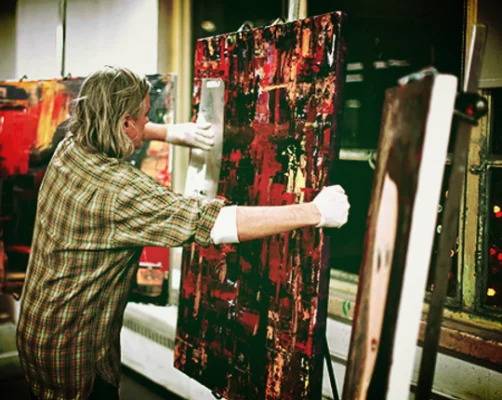
Lupri’s Artistic Process
Lupri’s process is deeply layered yet fluid, drawing from his rich background in music, philosophy, and psychology. His work evolves organically, often guided by a blend of dreams, symbols, and myth. Therefore, he often begins with an exploration of a theme, using palette knives to apply oil paint in broad, expressive strokes. This method allows him to build texture and depth, reflecting the complexity of his ideas. Lupri describes his process as a journey, where he “unearths hidden meanings” through each layer of paint, aiming to reveal the tension between the conscious and unconscious. While some artists might be inspired by one genre or style for periods of time, Lupri often shifts from working on an abstract piece to creating a portrait or a landscape very day to day. This versatility allows him to explore a wide range of themes and styles in his art.
Exploring Artistic Themes in His Work
Lupri’s body of work spans several genres, each reflecting different aspects of his artistic exploration. His paintings can be broadly categorized into three themes: portrait-inspired pieces, landscape works, and abstract compositions. Styylish proudly offers several Matthias Lupri Pieces today!
Portraits
Pieces like Joni, The Priestess, and Gato’s Dilemma draw from personal inspirations and figures of significance. For example, Joni, The Priestess is a tribute to Joni Mitchell, whose music has profoundly influenced Lupri. “Joni Mitchell has been a guiding light for me,” Lupri noted. “Her music has been a part of my life since my youth in Canada.”


Matthias Lupri’s Joni, the Priestess reflects his deep personal connection to Joni Mitchell, who, like Lupri, hails from Alberta, Canada. Their shared roots in the region have fostered a profound admiration and inspiration for Lupri. He describes Mitchell as a guiding light in his life, with her music deeply influencing his artistic vision.
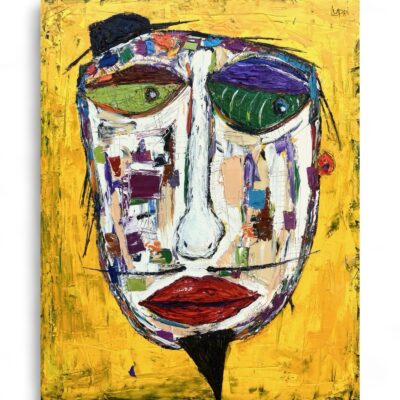

Matthias Lupri’s Gato’s Dilemma is a playful piece that showcases his characteristic use of thick palette knife strokes. Lupri describes the painting as a vibrant and dynamic exploration of character, inspired by his childhood doodling. The piece features expressive eyes and bold textures, capturing a whimsical figure caught in a metaphorical dilemma. “It’s just a fun figure,” Lupri explains, “with shifty eyes and a sense of confusion, reflecting a playful, almost pop-art sensibility.”
Landscapes
Paintings such as River’s Edge and Razor’s Edge are deeply rooted in Lupri’s childhood experiences in the Canadian Rockies. These works reflect his connection to the natural world and the formative landscapes of his youth. “These landscapes are part of my soul,” Lupri shared. “ They are places in my soul from you know, their memories, dreams, reflections on my youth, growing up in in Canada, on the foothill of the Rocky Mountains.”
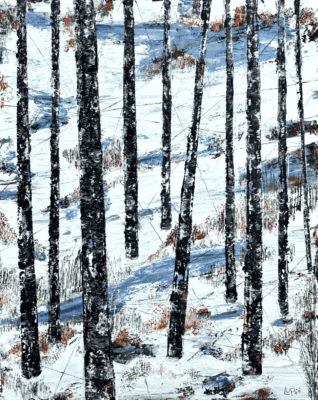

In his own words, River’s Edge reflects “the high water from the springtime, overflowing into the treeline.” This overflow not only signifies the dramatic change in the landscape but also ushers in the blooming of wildflowers, which bring vibrant life to the scene. However, the cyclical nature of the seasons is captured as the water eventually freezes again, hinting at the inevitable return of winter.
The painting’s texture plays a crucial role in conveying this transformation. Lupri describes the use of palette knife slashes in the painting. Initially applied unconsciously, they he now recognizes them as symbolic. These strokes, he notes, are reminiscent of “skate marks” from his childhood, adding a nostalgic layer to the work. “As kids, we played hockey and skated on the ice,”


Abstracts
Pieces like Okeo Square ’52 and Yodi ’24 explore geometric shapes and cosmic themes. Lupri described these works as a fusion of childhood experiences playing with shapes and his current exploration of cosmic balance. “These abstracts are about finding balance and harmony through geometric forms,” he explained.
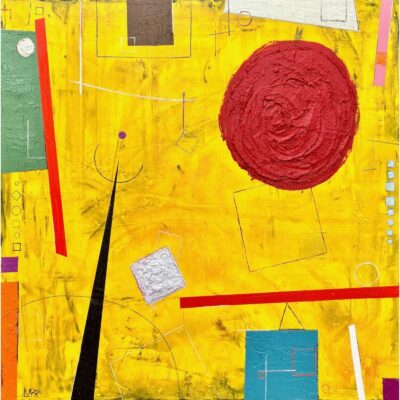

Matthias Lupri describes “Okeo Square 42” as an abstract piece inspired by his childhood memories of playing with protractors, rulers, and geometric shapes. The painting represents a cosmic balance, combining elements like moons or suns with precise geometric forms. The piece reflects the unconscious harmony of the universe, where everything is in balance, capturing a deep connection between the tangible and the cosmic through abstract shapes and balanced composition
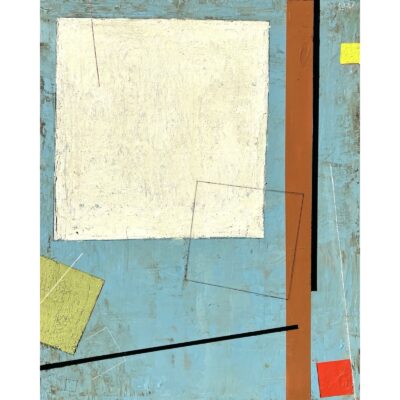

The Intersection of Art Forms
Lupri’s approach to art is notably interdisciplinary. His work in painting is complemented by previous experiences in music and photography. “Before painting, I was into photography, trying to capture the essence of my soul through images,” he said. “All these forms of art—music, photography, painting—they come from the same place and influence each other.”
This integration of art forms extends to his current practice, where he often finds connections between different artistic mediums. “I think of art as a whole,” Lupri said. “Just like in music, where I could jump from rock to jazz, in painting, I flow between landscapes, portraits, and abstracts.”
Myth, Dreams, and Philosophy
Central to Lupri’s work is an exploration of myth, dreams, and philosophy. He describes his artistic process as a dialogue with his unconscious mind, influenced by philosophical and psychological readings. “My art is about understanding the layers of the self and our place in the universe,” Lupri explained. “Carl Jung’s ideas, which I discovered later in my life, deeply resonate with my approach to art and self-discovery.”
His abstract works, in particular, reflect cosmic themes and the balance of energies. He described the concept of myth as “a powerful tool to bridge the conscious and unconscious realms,” emphasizing how these ancient stories connect us to “universal truths and shared human experiences.” He mentioned that by integrating mythological elements into his work, he hopes to “evoke a sense of wonder and reflection,” encouraging viewers to delve into “the timeless narratives that shape our understanding of the world.”
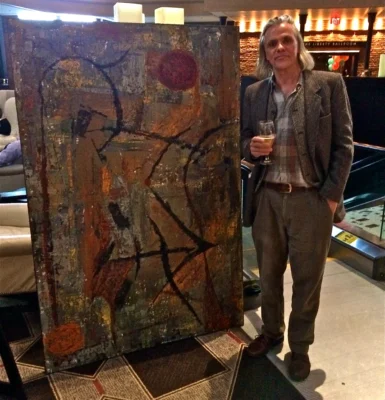

A Journey of Self-Discovery
Lupri’s artistic journey is marked by continuous self-discovery and personal growth. “The most significant realization for me has been that letting my work unfold naturally helps me grow as a person,” he said. Further, he says, “painting has made me a better human being and a freer artist.”
His work, which spans different styles and themes, continues to resonate with viewers and collectors, reflecting the depth of his exploration and the energy he imparts through his art. He doesn’t create work with the consumer in mind. However, the joy of creating a piece that resonates energetically is an immense joy for Lupri.
Lupri’s Ever-Evolving Artistic Expression
Matthias Lupri’s art is a rich tapestry of his diverse experiences and profound explorations. From the rhythmic beats of jazz music, his experience behind the camera with photography to the textured strokes of palette knife painting, Lupri’s work embodies a journey of self-discovery, mythological reflection, and philosophical inquiry. Thus, his paintings are not just visual representations but an ongoing dialogue with the unconscious mind, capturing the essence of human experience and artistic expression.
As Lupri continues to merge different art forms and explore new dimensions of creativity in his painting, his work remains a testament to the power of art as a vehicle for personal and universal exploration, and he will surely continue to innovate on the canvas.


